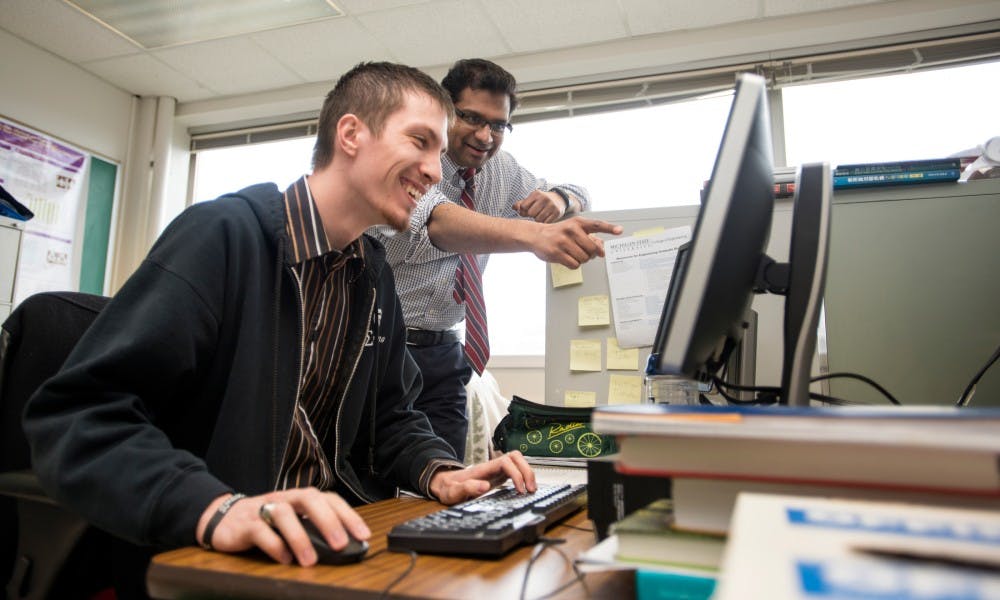From serving as a panelist at a United Nations Counter-Terrorism Committee to helping identify one of the Boston bombers, MSU professors who are part of the Biometrics Research Group are working to improve national security and law enforcement.
“Biometrics is the science of recognizing an individual through physical features and developing automatic methods and algorithms,” associate professor in the Department of Computer Science and Engineering Arun Ross said.
Ross was a panelist in 2013 at the United Nations Counter-Terrorism Committee held at the United Nations headquarters.
Ross said MSU’s Biometrics Research Group uses irises, fingerprints, faces and other identifying features.
“Suppose I give you two face images,” Ross said. “Humans look at the eyes first, then the mouth, forehead and hairstyle. Then we make a determination of who the person is. Computers look at the pixels, each one a color. An assembly of pixels is an image. So you can extract features from the images.”
Another professor from the Biometrics Research Group, Anil Jain, is known for his work identifying one of the Boston Marathon bombers using computer algorithms.
Jain was able to come up with a new way to accurately identify Dzhokhar Tsarnaev’s unclear picture.
“They couldn’t use any face recognition software to find the suspect,” Ross said. “He was in side profile and a baseball hat. ... Jain found if you replaced surveillance tapes with a hand-drawn sketch, you were more likely to get a matching hit.”
Jain found a way to circumvent the existing facial recognition software to make it a better fit for side-profile pictures. His method was used by the FBI and other government agencies.
Now, Ross’s biometrics lab at MSU is working on improving methods for ear recognition, which would improve side-profile recognition.
The lab is also improving methods for recognizing faces before and after heavy application of makeup.
“We submitted (our algorithms) to national enforcement agencies,” Ross said. “Once we submit them, we don’t know where our algorithms are used.”
Some of the government agencies the MSU biometrics lab works with are the FBI, the National Institute of Justice and the Department of Homeland Security.
The National Institute of Justice, NIJ, sponsored doctoral student Thomas Swearingen’s project in Ross’s lab.
Swearingen is trying to combine facial features with information available on social media.
“I am doing holistic matching,” Swearingen. “I look at occupation, age and social media. I want to know who their friends are, what they do.”
This is something the NIJ is deeply interested in, Swearingen said.
Another law enforcement issue students are working on in Ross’ lab is the potential digital tampering of images.
Doctoral student Sudipta Banerjee is working on a project in Ross’s lab to identify what camera a picture was taken from and whether or not the picture was digitally tampered with.
“This can minimize the chances of falsely implicating someone in a case,” Banerjee said.
Support student media!
Please consider donating to The State News and help fund the future of journalism.
Ross said Banerjee’s project could help the FBI’s efforts.
“An FBI agent could have a fingerprint image that he wants to match to someone to catch him, so he might tamper with it,” Ross said. “Sudipta’s project would detect the tampering.”
The other students in Ross’ lab are working on projects to make it easier to identify people.
Doctoral student Steven Hoffman is working on expanding iris recognition from identifying darkly colored eyes, something that is already established, to identifying blue and green eyes as well.
One of the applications of his project would be to create an iris scan on smartphones to unlock them.
Yaohui Ding is working on bringing the entire gender spectrum into the world of biometrics.
“Sometimes it can be difficult to determine gender,” Ding said. “Gender can also be changed.”
Ding is building a model that would avoid gender information altogether.
“Biometrics benefits society,” Ross said. “We want to minimize errors by law enforcement, give them state-of-the-art equipment and help with national security and prevention of attacks.”
Ross said biometrics is an important field.
“Recognizing individuals is a fundamental function in society,” Ross said. “We are automating this process. The power of biometrics is a large-scale recognition of individuals.”
Discussion
Share and discuss “MSU biometrics working to improve national security ” on social media.







